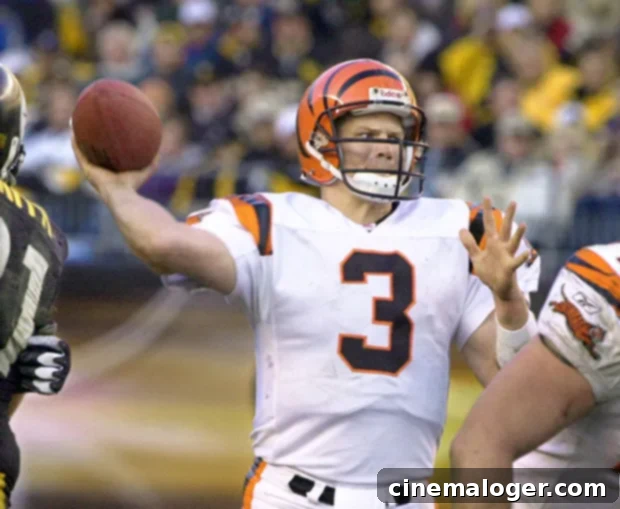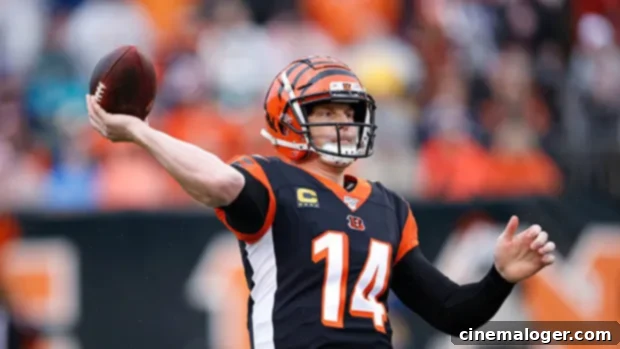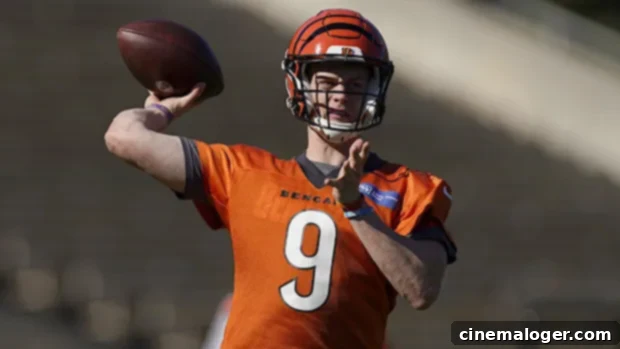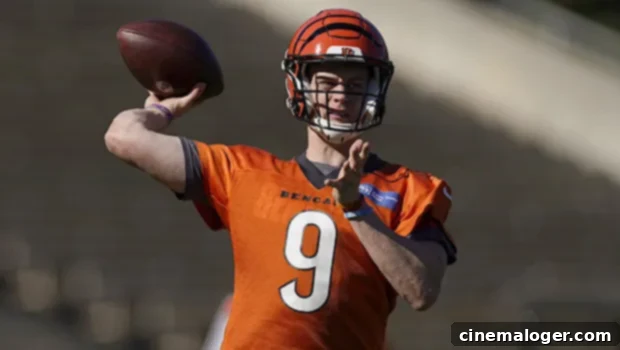From Past to Present: A Quarterback’s Journey to Super Bowl LVI for the Cincinnati Bengals
The anticipation is palpable among fans as the Cincinnati Bengals make their improbable run to Super Bowl LVI, where they are set to face the formidable Los Angeles Rams. This momentous occasion, scheduled for Sunday, February 13th, marks a significant milestone for the franchise and its dedicated fanbase, who have patiently awaited a return to the NFL’s biggest stage since their last appearance in Super Bowl XXIII in 1989 against the San Francisco 49ers.
Cincinnati stands as the sole team among the conference finalists of this season that has yet to hoist the coveted Vince Lombardi Trophy, placing immense weight and expectation on this upcoming championship game. The journey to this point has been long and winding, characterized by moments of brilliance, periods of rebuilding, and the persistent efforts of numerous players. Central to any NFL team’s success, particularly over two decades, is the leadership at the quarterback position. Here, we delve into the stories of the star quarterbacks who have steered the Bengals over the past 20 years, from the gritty determination of Jon Kitna to the cool, composed leadership of the team’s current sensation, Joe Burrow, exploring their impact, challenges, and enduring legacies.
Jon Kitna: The Resilient Catalyst

Jon Kelly Kitna, born on September 21, 1972, in Tacoma, Washington, forged his path to the NFL through sheer perseverance. His early athletic prowess was evident across multiple sports at Lincoln High School, where he excelled in basketball, baseball, and football. Kitna’s collegiate career at Central Washington University, where he initially walked onto the football team, saw him evolve into a star quarterback. Over four years, he played 43 games, amassing an impressive 12,353 passing yards, 99 touchdowns, and 59 interceptions, showcasing his potential despite playing at a smaller school.
Kitna’s entry into professional football was unconventional. After completing his math education degree, he was considering high school coaching jobs. It was during a scouting visit by Seattle Seahawks head coach Dennis Erickson, who was there to try out his nephew, that Kitna’s strong arm caught Erickson’s attention. This serendipitous encounter led to Kitna signing with the Seahawks as an undrafted free agent, a testament to his raw talent and an unexpected twist of fate. He played for Seattle from 1997 to 2000, gaining valuable NFL experience.
When the Seahawks opted not to re-sign him, the Cincinnati Bengals seized the opportunity, bringing Kitna aboard as an unrestricted free agent for the 2001 season. He quickly earned the starting quarterback role, starting 15 games and immediately bringing a much-needed injection of veteran leadership and stability to a struggling Bengals franchise. Kitna’s tenure with the Bengals, from 2001 to 2005, was marked by his unwavering dedication and resilience. His most celebrated season came in 2003, where he was rightfully named the NFL Comeback Player of the Year. That year, he threw for over 3,500 yards and 26 touchdown passes, guiding the Bengals to an 8-8 record—their first non-losing season since 1996, a significant achievement that laid groundwork for future improvements.
After his impactful years in Cincinnati, Kitna went on to play for the Detroit Lions and the Dallas Cowboys. His career was ultimately curtailed by a herniated disk problem in 2011, forcing his retirement from playing. Transitioning back to his initial passion, Kitna has since dedicated himself to football coaching, working with numerous schools. He currently serves as the head coach and athletic coordinator for Burleson High School in Burleson, Texas, continuing to influence young athletes with his experience and passion for the game.
Carson Palmer: The Heisman Hope

Carson Palmer, born on December 27, 1979, in Fresno, California, was earmarked for football greatness from an early age. Recognizing his son’s natural gifts—a commanding physical presence and exceptional arm strength—Carson’s father enrolled him in specialized training classes in Orange County, where he honed his skills under the tutelage of renowned quarterback guru Bob Johnson. Palmer’s high school career at Santa Margarita Catholic High School was nothing short of legendary, with teammates reportedly stopping their own practices to marvel at his talent. His collegiate recruitment was intense, drawing offers from powerhouse programs like Notre Dame and USC.
Palmer ultimately committed to the University of Southern California in 1998, where he blossomed into one of the nation’s most recognized quarterbacks by his junior year. His senior season in 2002 was historic; he shattered school records for most completions, passing yards, and passing touchdowns in a single season, culminating in him being awarded the prestigious 2002 Heisman Trophy. This unparalleled success positioned him as the undisputed top prospect heading into the NFL Draft.
In July 2003, Palmer signed a six-year, $42.69 million contract with the Cincinnati Bengals, joining the team with immense expectations as the first overall pick. He spent his rookie season observing and learning, benefiting from a “redshirt” year in the NFL that allowed him to fully grasp the complexities of the professional game without the pressure of immediate starts. By 2004, Palmer was handed the reins as the starting quarterback, and his impact was immediate. He led the Bengals from 2004 to 2010, ushering in an era of renewed hope and competitive football. His most notable season came in 2005, when he led the Bengals to an 11-5 record and their first AFC North title in 15 years, clinching a playoff berth. However, a devastating knee injury in the Wild Card game against the Pittsburgh Steelers prematurely ended his and the team’s promising postseason run, a moment that forever altered the trajectory of his Bengals career.
After a challenging period marked by injuries and a desire for a fresh start, Palmer famously informed head coach Marvin Lewis in 2010 of his intention to retire if not traded, leading to his eventual departure from Cincinnati. He then played for the Oakland Raiders from 2011 to 2012 and found significant success later in his career with the Arizona Cardinals from 2013 to 2017, where he revitalized his career and led them to an NFC Championship appearance. Palmer officially retired in 2018, concluding an illustrious career where he ranked 12th all-time in both passing yards (46,247) and passing touchdowns (294), solidifying his place as one of the league’s premier passers of his era.
Andy Dalton: The Red Rifle Era

Andrew Gregory Dalton, born on October 29, 1987, hails from Katy, Texas, where he first made a name for himself playing for the Katy High School Tigers. Despite starting only one full season as quarterback during his senior year, Dalton made an indelible mark, leading his team to the state finals. That season, he threw for an impressive 2,877 yards, with 42 touchdowns and just 15 interceptions, earning him the prestigious title of Greater Houston Area offensive player by the Houston Chronicle.
Dalton continued his collegiate career at Texas Christian University (TCU), starting in 2004, where he was redshirted his freshman year, allowing him to develop his skills. His time at TCU was exceptionally successful, highlighted by leading the Horned Frogs to a perfect 12-0 season in his junior year. In his senior season, he guided the team to a second consecutive Mountain West Conference Championship. By the end of his college tenure, Dalton held numerous school career records, including wins (42), passing yards (10,314), pass attempts (1,317), completions (812), and completion percentage (61.6%), solidifying his status as a top quarterback prospect.
In the 2011 NFL Draft, the Cincinnati Bengals selected Andy Dalton as their second-round pick, 35th overall. He immediately stepped into the starting role, a rare feat for a rookie quarterback, and quickly began to establish himself. By the end of his inaugural season, he earned the NFL Players Association Emerging Player Award and was named a Pro Bowl Alternate, signaling a promising future. Dalton led the Bengals as their starting quarterback from 2011 to 2019, an era often affectionately dubbed the “Red Rifle” era by fans.
Under Dalton’s leadership, the Bengals experienced a period of consistent competitiveness, making five consecutive playoff appearances from 2011 to 2015, a franchise record. While postseason victories eluded the team during his tenure, Dalton consistently demonstrated his ability to lead a potent offense and deliver clutch performances. He holds numerous Bengals franchise records, including career touchdown passes (204) and ranks second in passing yards (31,594). His nine seasons with the Bengals ended in 2020 when the team, embarking on a full rebuild, decided to release him in favor of their first overall pick, Joe Burrow.
Following his departure from Cincinnati, Dalton signed a one-year, $7 million contract with the Dallas Cowboys in March 2020, where he stepped in after injuries to Dak Prescott, helping the team finish with a 6-10 record. He then moved to the Chicago Bears, signing another one-year, $10 million contract. In Chicago, he began as the starter but was eventually relegated to a backup role behind rookie Justin Fields after suffering a knee injury. Despite this, Dalton demonstrated his veteran experience, stepping in when Fields suffered a rib injury against the Baltimore Ravens, though the Bears ultimately lost 13-16. For the 2021 season, Dalton passed for 1,512 yards, eight touchdowns, and nine interceptions across eight games, continuing his career as a reliable and experienced NFL quarterback.
Joe Burrow: The Franchise Savior

Joseph Lee Burrow, born on December 10, 1996, in Ames, Iowa, was immersed in the world of football from an early age, benefiting from his father’s career as a collegiate football coach. His collegiate journey began at Ohio State, where he redshirted his freshman year and played sparingly in 10 games over two seasons. Seeking a starting opportunity, Burrow transferred to Louisiana State University (LSU) in 2018, a decision that would ultimately change the landscape of college football and his career.
The 2019 season became legendary for Joe Burrow and the LSU Tigers. He engineered one of the most statistically dominant seasons in college football history, leading LSU to an undefeated 15-0 record and a National Championship victory, triumphing over the Clemson Tigers with a decisive 42-25 score. During this spectacular year, Burrow broke numerous NCAA and SEC records, showcasing incredible accuracy, composure under pressure, and dynamic playmaking ability. His phenomenal performance earned him the prestigious Heisman Trophy by the largest margin in history, solidifying his status as a generational talent.
After five remarkable years in college football, the hype surrounding Joe Burrow entering the 2020 NFL Draft was immense. Predictably, he was selected as the Overall No. 1 Draft Pick by the Cincinnati Bengals, becoming the third consecutive Heisman-winning quarterback to be chosen first overall, following Baker Mayfield for the Cleveland Browns and Kyler Murray for the Arizona Cardinals. In July 2020, Burrow signed a four-year contract worth $36.1 million, signaling the Bengals’ commitment to him as their franchise quarterback.
Burrow’s rookie season in 2020, though admirable in its display of talent and leadership, was tragically cut short. After showing immense promise and breaking several rookie passing records, he suffered a devastating torn ACL and MCL in his left knee, along with other damage to his PCL and meniscus, sidelining him for the remainder of the season. Placed on injured reserve, the Bengals faithful held their breath for his return.
True to his resilient spirit, Joe Burrow returned for the 2021 season stronger and more determined than ever. Dubbed “Joe Cool” for his calm demeanor in high-pressure situations, he led the Bengals on an improbable and thrilling playoff run. His exceptional connection with rookie wide receiver Ja’Marr Chase ignited the Bengals’ offense, transforming them into one of the league’s most exciting teams. In a memorable AFC Championship Game against the formidable Kansas City Chiefs, Burrow threw for 250 yards, two touchdowns, and one interception, but more importantly, he engineered a remarkable comeback, leading the Bengals to a 27-24 overtime victory. This historic win propelled the Cincinnati Bengals to Super Bowl LVI, marking the culmination of decades of anticipation and signaling a new era for the franchise under the leadership of their charismatic young quarterback.
The journey of the Cincinnati Bengals to Super Bowl LVI is a narrative woven through the contributions of these impactful quarterbacks. From the foundational efforts of Kitna, the explosive potential of Palmer, the consistent leadership of Dalton, to the transcendent talent and cool resolve of Burrow, each has played a pivotal role in shaping the team’s destiny. Now, with Joe Burrow at the helm, the Bengals stand on the precipice of history, hoping to cap this incredible journey with the ultimate prize and bring the Lombardi Trophy home to Cincinnati.
